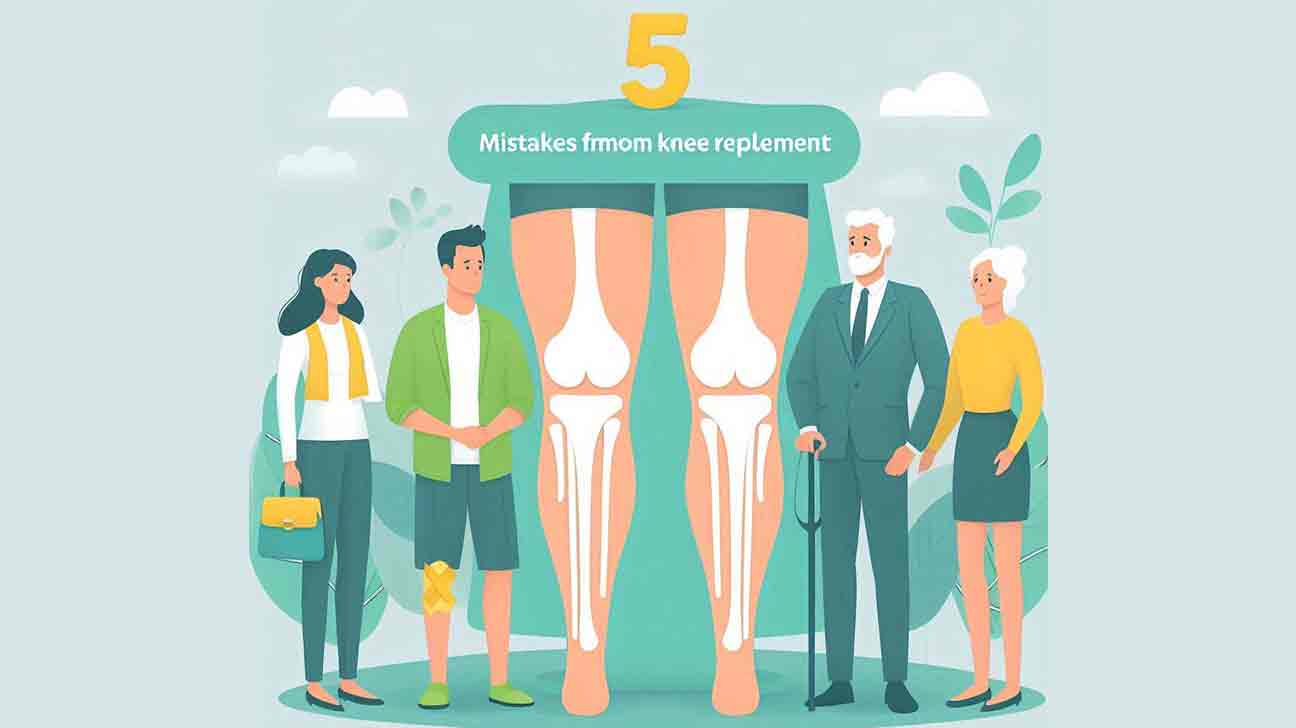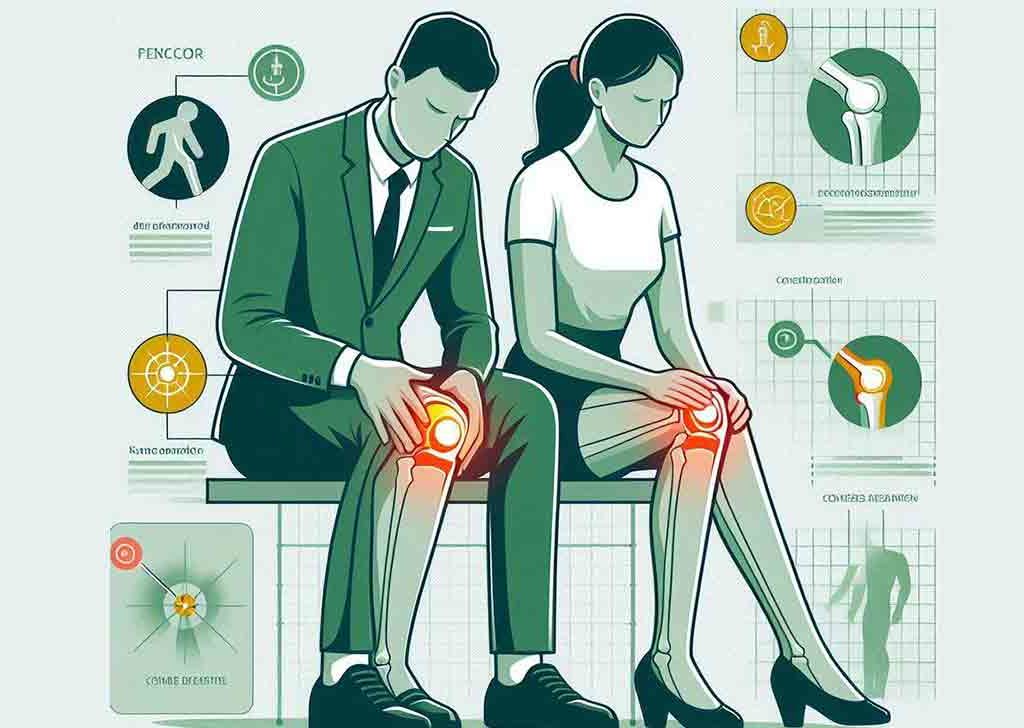Knee replacement surgery is a common procedure aimed at relieving pain and restoring function in severely diseased knee joints. Understanding what this surgery entails and how to navigate recovery is crucial for optimal results.
What is Knee Replacement?
Knee replacement involves the surgical removal of damaged or diseased parts of the knee joint, which are then replaced with artificial components. The surgery can significantly improve mobility and quality of life for individuals suffering from conditions such as arthritis.
Types of Knee Replacement Surgeries
- Total Knee Replacement (TKR): Involves replacing the entire knee joint.
- Partial Knee Replacement (PKR): Only part of the knee joint is replaced, typically when damage is limited to a specific area.
- Revision Knee Replacement: A follow-up surgery to replace or repair a previously implanted knee prosthesis.
Benefits of Knee Replacement
- Pain Relief: Substantial reduction in knee pain.
- Improved Mobility: Increased range of motion and ability to perform daily activities.
- Enhanced Quality of Life: Greater participation in physical activities and reduced dependence on pain medications.
Knee Replacement
1. Neglecting Rehabilitation
Rehabilitation is critical to restoring function after knee replacement. Patients often underestimate the importance of physical therapy, leading to slower recovery and suboptimal results.
Importance of Physical Therapy
- Restores Mobility: Helps regain strength and flexibility.
- Reduces Pain: Assists in managing postoperative discomfort.
- Improves Outcomes: Patients who engage in rehabilitation typically see better functional results.
Common Rehabilitation Exercises
- Straight Leg Raises: Strengthens quadriceps without stressing the knee.
- Heel Slides: Promotes knee flexion and mobility.
- Quadriceps Sets: Engages thigh muscles while maintaining a stable position.
Timeline for Recovery
- Initial Phase (0-2 weeks): Focus on pain management and gentle mobility exercises.
- Intermediate Phase (2-6 weeks): Increase intensity of physical therapy, emphasizing strengthening and flexibility.
- Advanced Phase (6+ weeks): Gradually return to normal activities, incorporating more challenging exercises.
2. Ignoring Pain Management
Postoperative pain is expected after knee replacement. However, ignoring effective pain management can hinder recovery.
Understanding Pain After Surgery
Patients may experience varying levels of pain due to inflammation, surgical trauma, and muscle adjustments. Recognizing this pain is essential for effective management.
Medication Options
- NSAIDs: Non-steroidal anti-inflammatory drugs to reduce inflammation.
- Opioids: Prescribed for severe pain but should be used cautiously due to addiction risks.
- Topical Analgesics: Creams and patches for localized pain relief.
Non-Medical Pain Relief Techniques
- Ice Therapy: Reduces swelling and numbs pain.
- Heat Therapy: Can help relax stiff muscles after the initial swelling subsides.
- Relaxation Techniques: Yoga, meditation, or breathing exercises to manage discomfort.
3. Returning to Activities Too Soon
Rushing back to normal activities can lead to complications, including joint stiffness and increased pain.
Signs You’re Ready
- Reduced pain levels.
- Improved range of motion.
- Strength regained in the leg muscles.
Activities to Avoid Initially
- High-impact sports (running, jumping).
- Heavy lifting.
- Twisting or pivoting movements.
Gradual Return to Sports
Consult with a physical therapist to create a personalized plan for safely returning to sports and other activities.
4. Inadequate Follow-Up Care
Regular follow-ups are essential to monitor the progress of recovery and address any complications.
Importance of Regular Check-Ups
- Monitor Healing: Ensure the knee is healing correctly.
- Assess Function: Evaluate mobility and strength.
- Adjust Treatment: Modify rehabilitation based on progress.
What to Expect During Follow-Ups
- Physical assessments to check knee stability and strength.
- Discussions about pain levels and mobility concerns.
- Imaging tests (X-rays) to evaluate the positioning of the prosthesis.
Monitoring Progress Effectively
Keep a journal of daily activities, pain levels, and exercises to discuss during follow-ups. This will provide valuable insights to your healthcare provider.
5. Neglecting Nutrition and Hydration
Proper nutrition and hydration play a vital role in the recovery process.
Nutrition’s Role in Recovery
- A balanced diet promotes healing and provides energy for rehabilitation.
- Essential vitamins and minerals (like Vitamin D and Calcium) support bone health.
Foods to Eat Post-Surgery
- Lean Proteins: Chicken, fish, beans for muscle repair.
- Fruits and Vegetables: Rich in antioxidants to reduce inflammation.
- Whole Grains: Provide energy and fiber for overall health.
Hydration Tips for Recovery
- Drink plenty of water to stay hydrated.
- Limit caffeine and alcohol as they can interfere with healing.
Success Stories
Real-Life Experiences
Hearing from individuals who have successfully navigated knee replacement can provide inspiration and motivation.
Lessons Learned from Others
- Importance of following rehabilitation guidelines.
- Staying positive throughout the recovery journey.
- Seeking support from family, friends, and healthcare providers.
Resources for Patients
Support Groups
Connecting with others who have undergone similar experiences can provide emotional support and practical advice.
Online Forums and Communities
Participating in online discussions can help patients share experiences and tips.
Useful Apps for Recovery
- Rehab exercises: Apps that guide patients through physical therapy exercises.
- Pain management: Journals to track pain levels and medication usage.
FAQs
Common Questions About Knee Replacement
- How long does recovery take?
- Recovery can take several weeks to months, depending on individual factors.
- Will I need physical therapy?
- Yes, physical therapy is essential for successful recovery.
Myths and Misconceptions
- Myth: Surgery guarantees immediate relief.
- Fact: Recovery takes time and effort.
Contact Information
Consultation Booking
For personalized advice and treatment plans, consider scheduling a consultation with a healthcare professional.
Feedback and Inquiries
If you have questions or feedback regarding knee replacement, please reach out to your healthcare provider.

The top 5 mistakes after knee replacement surgery include skipping therapy, not taking proper medication, doing too much activity too soon, not using pain management techniques, and not having a plan for after surgery. These mistakes can lead to complications and prolonged recovery time.
It’s important to follow the prescribed exercise routine, take medication as directed, gradually increase activity level, manage pain effectively, and have a plan in place for post-surgery care. In this blog post, we will discuss each of these mistakes in detail and provide tips on how to avoid them for a successful knee replacement recovery.
Top 5 Mistakes After Knee Replacement
Introduction To Knee Replacement Recovery
Avoid these top 5 mistakes after knee replacement surgery to ensure a successful recovery: skipping therapy and exercise, neglecting proper medication, overexerting yourself too soon, not managing pain effectively, and failing to have a post-surgery plan in place. By avoiding these errors, you can optimize your knee replacement recovery and regain mobility and functionality.
Initial Recovery Phase
After knee replacement surgery, the initial recovery phase is crucial for optimal healing and rehabilitation. Patients may experience pain, swelling, and limited mobility during this period. Following the surgeon’s post-operative instructions, including elevation, icing, and prescribed medication, is essential for managing discomfort and promoting recovery.
Setting Realistic Expectations
Setting realistic expectations is vital for a successful knee replacement recovery. Patients should understand that while the surgery aims to improve mobility and reduce pain, it is a gradual process. It’s important to avoid overexertion and adhere to the prescribed physical therapy and exercise regimen to achieve the best outcomes.
The Lure Of Overexertion
After undergoing knee replacement surgery, it’s natural to want to resume your normal activities as quickly as possible. However, the lure of overexertion can lead to serious consequences and hinder your recovery process. In this section, we will explore the top 5 mistakes people make after knee replacement surgery, focusing on the subheading: The Lure of Overexertion.
Too Much Activity
One of the most common mistakes people make after knee replacement surgery is engaging in too much activity too soon. It’s important to remember that your body needs time to heal and adjust to the new knee joint. Pushing yourself too hard can result in increased pain, swelling, and even damage to the surgical site.
Instead, it’s crucial to listen to your body and gradually increase your activity levels as advised by your healthcare provider. Start with gentle exercises and gradually progress to more challenging activities over time. Remember, slow and steady wins the race when it comes to recovering from knee replacement surgery.
Identifying Safe Exercise Limits
Another mistake people often make is failing to identify their safe exercise limits. While it’s important to stay active during your recovery, it’s equally important to know your boundaries and not exceed them. Pushing yourself beyond your limits can lead to setbacks and prolong your recovery process.
Consult with your physical therapist or healthcare provider to determine the appropriate exercise limits for your specific situation. They can guide you in choosing exercises that are safe and beneficial for your knee replacement recovery. By staying within these limits, you can prevent unnecessary strain and ensure a smoother recovery.
Remember, knee replacement surgery is a major procedure, and it’s important to give your body the time it needs to heal properly. By avoiding the lure of overexertion and making these common mistakes, you can optimize your recovery and get back to enjoying a pain-free and active lifestyle.
Neglecting Prescribed Therapy
One of the top 5 mistakes after knee replacement is neglecting prescribed therapy. It’s important to follow the recommended exercise routine to aid in the recovery process and regain strength and mobility in the knee. Skipping therapy can hinder the healing progress and lead to potential complications.
Skipping Rehabilitation Sessions
One of the top mistakes after knee replacement is skipping therapy sessions.
Long-term Consequences
Neglecting prescribed therapy can lead to long-term consequences.
Medication Mismanagement
Avoiding medication mismanagement is crucial after knee replacement surgery. The top 5 mistakes include skipping prescribed medication, overexerting, neglecting pain management, disregarding physical therapy, and lacking a post-surgery plan. Proper medication adherence and care are essential for a successful recovery.
Pain Relief Pitfalls
One of the common mistakes people make after knee replacement surgery is medication mismanagement, which can hinder the pain relief process. Proper pain management is crucial for a smooth recovery and optimal outcomes. However, there are several pitfalls to be aware of when it comes to pain relief medication.
Anti-inflammatory Precautions
Another important aspect of medication management after knee replacement surgery is taking necessary precautions with anti-inflammatory drugs. While these medications can help reduce swelling and inflammation, they should be used with caution to avoid potential complications. Here are some anti-inflammatory precautions to keep in mind:
- Avoid taking anti-inflammatory medications on an empty stomach to prevent stomach irritation.
- Follow the recommended dosage and duration as prescribed by your healthcare provider.
- Inform your healthcare provider about any other medications you are taking to avoid potential drug interactions.
- Be cautious of any allergic reactions or side effects and report them to your healthcare provider immediately.
By adhering to these anti-inflammatory precautions, you can ensure the safe and effective use of these medications during your recovery.
Ignoring Pain And Swelling
Ignoring pain and swelling is one of the top 5 mistakes to avoid after knee replacement surgery. It’s important to address any discomfort and inflammation promptly to ensure proper healing and prevent complications.
Ignoring Pain and Swelling after a knee replacement surgery can lead to serious complications. While it is normal to experience some pain and swelling in the first few weeks after the surgery, it is important to understand the warning signs of potential problems. Some patients may ignore these symptoms and delay seeking medical advice, which can lead to serious complications.
Understanding Warning Signs It is important to understand the difference between normal pain and swelling and warning signs of potential complications. Normal pain and swelling should gradually decrease over time, while warning signs may include sudden or severe pain, redness, warmth, or tenderness in the affected area. If you experience any of these symptoms, it is important to seek medical advice immediately.
When to Seek Medical Advice If you experience any warning signs or have concerns about your recovery after knee replacement surgery, do not hesitate to seek medical advice. Delaying medical attention can lead to serious complications and may require additional surgeries or prolonged recovery time. It is better to be safe than sorry and seek medical attention as soon as possible.
To avoid Ignoring Pain and Swelling after knee replacement surgery, it is important to follow the post-surgery instructions provided by your doctor and physical therapist. This includes taking prescribed medications, attending physical therapy sessions, and avoiding activities that can put stress on the knee joint. By taking these steps, you can ensure a smooth and successful recovery from knee replacement surgery.
Assistive Device Dilemmas
One of the most common mistakes individuals make after knee replacement surgery is related to assistive devices. Premature discontinuation, finding the right balance, and ensuring proper usage are essential aspects of assistive device management that can significantly impact the recovery process.
Premature Discontinuation
Many patients make the mistake of prematurely discontinuing the use of assistive devices such as walkers, canes, or crutches. While it’s natural to want to regain independence as quickly as possible, prematurely abandoning these devices can lead to unnecessary strain on the knee joint and hinder the recovery process.
Finding The Right Balance
Finding the right balance in the use of assistive devices is crucial. Over-reliance on these devices can slow down the rehabilitation process, while underutilization can lead to increased stress on the knee joint. Striking a balance that supports mobility and stability is essential for a successful recovery.
Rushing Back To Work
Evaluating Job Demands
Assess physical requirements of job post-surgery.
Phased Return Strategies
Gradually increase work hours over time.
Inadequate Pain Management Techniques
One of the top mistakes after knee replacement surgery is inadequate pain management techniques. Effective pain management is crucial for a smooth recovery process. Failing to address pain properly can lead to discomfort, delayed healing, and overall dissatisfaction with the surgical outcome.
Alternative Pain Relief Methods
Consider exploring alternative pain relief methods to supplement traditional medication. These may include acupuncture, massage therapy, or using heat and cold therapy to alleviate discomfort.
Importance Of Pain Tracking
Tracking your pain levels is essential post-surgery. By monitoring and documenting your pain levels, you can provide valuable information to your healthcare provider, allowing for adjustments in your pain management plan as needed.
Lack Of Post-operative Planning
One of the top mistakes after knee replacement surgery is the lack of post-operative planning. Proper planning is essential for a successful recovery and to avoid complications.
Recovery Environment Setup
Creating a conducive recovery environment at home is crucial. Ensure a clutter-free space, comfortable seating, and accessibility to necessities within arm’s reach.
Support System Essentials
Having a strong support system is vital. Arrange for assistance with daily tasks, transportation to appointments, and emotional support during the recovery period.
Failing To Modify Lifestyle
One of the top 5 mistakes after knee replacement is failing to modify lifestyle, such as skipping therapy and overdoing physical activities. It’s crucial to follow prescribed exercises, manage pain effectively, and have a post-surgery plan in place for optimal recovery and long-term joint health.
Long-term Activity Adjustments
After knee replacement, it’s crucial to make long-term adjustments to your activity levels to ensure proper healing.
Diet And Nutrition Considerations
Proper diet and nutrition play a key role in the recovery process post knee replacement surgery.
Avoiding Movement Entirely
One of the top 5 mistakes after knee replacement surgery is avoiding movement entirely. While it’s important to be cautious, completely avoiding movement can hinder the recovery process. Engaging in lower-impact activities like hiking, gardening, swimming, playing tennis, and golfing can help improve mobility and strengthen the knee joint.
Dangers Of A Sedentary Lifestyle
After knee replacement surgery, avoiding movement entirely can lead to a sedentary lifestyle, which comes with its own set of dangers. Prolonged periods of inactivity can lead to muscle weakness, reduced joint flexibility, and increased risk of blood clots. Additionally, a sedentary lifestyle can contribute to weight gain, which puts added stress on the new knee joint.
Gentle Mobility Exercises
To counteract the dangers of a sedentary lifestyle, incorporating gentle mobility exercises into your daily routine is crucial for a successful recovery after knee replacement surgery. These exercises help improve blood circulation, maintain joint flexibility, and prevent muscle atrophy. Gentle mobility exercises also play a key role in regaining strength and improving overall mobility, enabling a smoother transition back to daily activities.
High-impact Activity Hazards
After a knee replacement surgery, it is important to avoid high-impact activities such as downhill skiing and contact sports like football or soccer. One should focus on lower-impact activities like hiking, gardening, swimming, playing tennis, and golfing. Common mistakes include skipping therapy, not taking prescribed medication, doing too much activity too soon, ignoring severe pain or complications, and not having a plan in place for after the surgery.
High-Impact Activity Hazards can pose a significant risk for individuals who have had knee replacement surgery. Running and jumping are two high-impact activities that should be avoided as they can put undue stress on the knee joint and may cause damage to the new replacement. It is important to note the risks associated with these activities to ensure proper healing and prevent further injury. In this section, we will discuss the Risks of Running and Jumping and provide Low-Impact Sports Alternatives to help avoid such hazards.
Risks Of Running And Jumping
Running and jumping can cause significant damage to the knee joint and should be avoided after knee replacement surgery. These high-impact activities can put undue stress on the joint and may cause pain, swelling, or even damage to the new replacement. It is important to avoid these activities until your doctor gives you the go-ahead to resume normal activities.
Low-impact Sports Alternatives
While running and jumping should be avoided, there are still many low-impact sports alternatives that can help maintain a healthy and active lifestyle. These activities can provide a great workout without putting undue stress on the knee joint. Some great options include hiking, cycling, swimming, and yoga. These activities can help build strength, improve flexibility, and provide cardiovascular benefits without the risk of damaging the new knee replacement. In conclusion, it is important to avoid high-impact activities such as running and jumping after knee replacement surgery. These activities can put undue stress on the joint and may cause damage to the new replacement. Instead, focus on low-impact sports alternatives to help maintain a healthy and active lifestyle while ensuring proper healing and preventing further injury.

Disregarding Therapist’s Exercise Prescription
One of the top 5 mistakes after knee replacement is disregarding the therapist’s exercise prescription. Failing to follow the recommended exercises can hinder the recovery process and lead to limited mobility. It is crucial to adhere to the exercise plan to ensure a successful rehabilitation and optimal outcomes.
Role Of Physical Therapy
Physical therapy plays a crucial role in the recovery process after knee replacement surgery. It helps to improve strength, flexibility, and mobility in the affected knee, allowing patients to regain their independence and resume their daily activities.
During physical therapy sessions, the therapist will assess the patient’s condition and create a customized exercise program tailored to their specific needs. This program is designed to gradually increase the strength and range of motion in the knee, while also addressing any post-operative pain or discomfort.
By following the therapist’s exercise prescription diligently, patients can expect to see significant improvements in their knee function and overall quality of life. However, disregarding the therapist’s exercise prescription is a common mistake that can hinder the recovery process and lead to suboptimal outcomes.
Customized Exercise Programs
Customized exercise programs are an essential component of post-knee replacement rehabilitation. These programs are specifically tailored to the individual patient’s needs, taking into account factors such as their age, overall health, and the specific type of knee replacement they underwent.
The exercises prescribed by the therapist are carefully chosen to target the muscles surrounding the knee joint, aiming to improve strength, stability, and flexibility. They may include a combination of stretching, strengthening, and low-impact aerobic exercises.
Following a customized exercise program not only helps to restore the function of the new knee joint but also plays a significant role in preventing complications such as stiffness, muscle weakness, and joint instability.
It is crucial to adhere to the prescribed exercise program and perform the exercises as instructed by the therapist. Skipping or disregarding these exercises can impede the recovery process and lead to a delay in regaining full knee function.
By prioritizing physical therapy and following the customized exercise program, patients can optimize their recovery after knee replacement surgery and achieve the best possible outcomes.
Returning To Work Prematurely
Returning to work prematurely after knee replacement surgery can lead to complications and hinder your recovery process. It is crucial to allow your body enough time to heal properly before resuming work responsibilities.
Workplace Accommodations
Discuss with your employer about potential workplace accommodations to support your return to work after knee replacement surgery. This may include ergonomic adjustments, flexible work hours, or modified duties to ensure a smooth transition back to your job.
Communicating With Employers
Openly communicate with your employers about your recovery progress and any challenges you may face upon returning to work. It is important to set realistic expectations and seek support from your employer to facilitate a successful return to work process.
Pain Management Neglect
Following knee replacement surgery, it is crucial to avoid common mistakes that can hinder recovery. These include skipping therapy, neglecting prescribed exercises, improper medication intake, overexertion, and not utilizing effective pain management techniques. It is essential to have a well-structured plan post-surgery to optimize results and ensure a smooth rehabilitation process.
Effective Pain Control Strategies
One of the top mistakes people make after knee replacement surgery is neglecting proper pain management. Pain is a common and expected part of the recovery process, but it is crucial to address it effectively. By implementing the right pain control strategies, you can ensure a smoother and more comfortable recovery.
Balancing Medications And Therapy
Properly balancing medications and therapy is essential for effective pain management after knee replacement. This involves finding the right combination of pain medications, such as nonsteroidal anti-inflammatory drugs (NSAIDs) and opioids, to alleviate discomfort while allowing for active participation in physical therapy.
It’s important to follow your healthcare provider’s instructions regarding medication dosage and frequency. Be aware of any potential side effects and communicate any concerns or changes in pain levels to your healthcare team. This way, they can adjust your medication plan accordingly. In addition to medications, physical therapy plays a crucial role in managing pain after knee replacement.
It helps improve joint mobility, strength, and function, which can ultimately reduce pain. It is important to stay consistent with your therapy sessions and actively participate in the prescribed exercises.
Proper pain management is crucial after knee replacement surgery to ensure a successful recovery. By implementing effective pain control strategies and balancing medications with therapy, you can minimize discomfort and optimize your rehabilitation process.
Remember to consult with your healthcare team for personalized guidance and to address any concerns or changes in pain levels.
Post-surgery Sedentary Lifestyle
After knee replacement surgery, it’s crucial to avoid falling into a sedentary lifestyle. Failure to incorporate regular movement into your daily routine can lead to various risks and complications. Let’s explore the potential consequences of inactivity and the importance of integrating daily movement into your post-surgery life.
Risks Of Inactivity
Remaining sedentary after knee replacement surgery can increase the risk of blood clots, muscle weakness, and joint stiffness. Prolonged inactivity may also hinder the recovery process and lead to a longer rehabilitation period. Moreover, it can contribute to weight gain, which places additional stress on the new knee joint, potentially compromising its longevity.
Incorporating Daily Movement
It’s essential to introduce gentle, low-impact activities into your daily routine following knee replacement surgery. Consider incorporating short walks, light stretching exercises, and prescribed physical therapy sessions to promote joint flexibility and muscle strength. Gradually increasing your activity level under the guidance of your healthcare provider can expedite your recovery and improve overall mobility.
Ignoring Physical Limitations
After knee replacement surgery, it’s crucial to recognize and respect the physical limitations of your new knee. Ignoring these limitations can lead to complications and hinder the recovery process.
Respecting Your New Knee
Respecting your new knee means being mindful of its capabilities and limitations. Avoiding high-impact activities and excessive strain is essential to ensure the longevity of your knee replacement.
Adapting To Permanent Restrictions
Adapting to permanent restrictions involves embracing a new lifestyle that accommodates the limitations of your replaced knee. This may require adjustments in daily activities and recreational pursuits.
It’s important to remember that your new knee is not invincible, and it’s necessary to adapt to a modified routine that aligns with its capabilities.
The Worst Days Of Recovery
Recovery after knee replacement can be challenging. The top 5 mistakes to avoid include skipping therapy, neglecting medication, overexerting yourself, not managing pain effectively, and lacking a post-surgery plan. It’s crucial to follow proper care guidelines for a successful recovery journey.
Coping With Post-operative Pain
One of the biggest challenges during the recovery process after knee replacement surgery is coping with post-operative pain. It is essential to follow the prescribed pain management techniques to alleviate discomfort and promote healing. Ignoring severe pain or complications can lead to further complications and delay the recovery process.
Mental Health During Recovery
Recovering from knee replacement surgery not only takes a toll on the physical body but also on mental health. It is common to experience feelings of frustration, impatience, and even sadness during the recovery period. It is important to acknowledge these emotions and seek support from loved ones or professionals if needed. Taking care of your mental health is just as crucial as taking care of your physical well-being.
Here are some key points to remember during the worst days of recovery:
- Follow the prescribed pain management techniques to alleviate discomfort.
- Do not ignore severe pain or complications; seek medical assistance if necessary.
- Take care of your mental health and seek support if needed.
- Be patient with the recovery process and avoid rushing into activities that may strain your new knee joint.
- Stay positive and focus on the progress you have made so far.
Remember, the worst days of recovery are temporary, and with proper care, you will gradually regain your mobility and enjoy the benefits of your knee replacement surgery.
Sleeping Troubles Post-surgery
Post-surgery, avoid common mistakes after knee replacement to prevent sleeping troubles. Skip therapy, neglect pain management, overdo activities, ignore complications, and lack a post-surgery plan. Strive for a smooth recovery by following prescribed exercises, taking medication, pacing activities, managing pain, and planning ahead for optimal healing.
Sleeping Troubles Post-Surgery: Sleeping after knee replacement surgery can be a challenge. Many patients struggle with finding a comfortable position to sleep in due to pain, stiffness, and swelling. In this section, we’ll discuss the top 5 mistakes patients make when it comes to sleeping after knee replacement surgery and provide helpful tips on how to improve your sleep quality.
H3: Best Sleeping Positions The best sleeping positions after knee replacement surgery are on your back or on your non-operated side. Sleeping on your back with a pillow under your knees can help reduce pressure on your knee joint and provide support to your lower back. If you prefer to sleep on your side, place a pillow between your legs to keep your knees and hips aligned.
H3: Sleep Aids and Techniques Sleep aids and techniques can help improve your sleep quality after knee replacement surgery. Over-the-counter pain medication can be taken before bedtime to help reduce pain and discomfort.
Using ice or heat therapy before bed can also help reduce swelling and stiffness. Relaxation techniques such as deep breathing exercises or meditation can help calm your mind and body before bed. Here are some additional tips to help you improve your sleep quality after knee replacement surgery: – Avoid caffeine, alcohol, and nicotine before bedtime. –
Create a relaxing bedtime routine. – Keep your bedroom cool, dark, and quiet. – Use a comfortable mattress and pillows. – Don’t watch TV or use electronic devices in bed. In conclusion, sleeping troubles after knee replacement surgery are common, but there are ways to improve your sleep quality. By following these tips and using the right sleeping aids and techniques, you can get the restful sleep you need to aid in your recovery.
Conclusion: Embracing A New Normal
Embracing a new normal after knee replacement involves avoiding common mistakes. These include skipping therapy, neglecting prescribed exercises, not managing pain effectively, overexerting too soon, and lacking a post-surgery plan. By steering clear of these errors, patients can enhance their recovery and adjust to their new knee function smoothly.
Summarizing Key Points
After undergoing knee replacement surgery, it is important to avoid common mistakes that can hinder your recovery. These mistakes include skipping therapy, not taking medication as prescribed, doing too much activity too soon, not managing pain properly, and not having a plan in place for after surgery.
Positive Outlook On Recovery
While recovering from knee replacement surgery can be challenging, it is important to maintain a positive outlook on your recovery. Focus on the progress you are making, celebrate small victories, and don’t be too hard on yourself if you experience setbacks. With time and effort, you will be able to embrace a new normal and enjoy the activities you love once again.

Frequently Asked Questions
What Can You Never Do After A Knee Replacement?
After a knee replacement, you should avoid downhill skiing, contact sports like football, and activities that involve jerking or twisting movements. Instead, opt for lower-impact activities such as swimming, hiking, gardening, playing tennis, and golfing to protect your new knee joint.
What Is The Biggest Complaint After Knee Replacement?
The biggest complaint after knee replacement is persistent pain or dissatisfaction with the function of the new knee joint. While most people experience an improvement in pain after surgery, some may continue to experience pain or have difficulty with mobility.
It is important to follow proper post-operative care and avoid high-impact activities to prevent complications.
What Are Red Flags After Knee Surgery?
Red flags after knee surgery include oozing or pus from the wound, persistent redness, tenderness, swelling, or pain in the knee that is not improving or getting worse. These symptoms may indicate an infection or other complications and should be addressed by a medical professional.
What Are The Hardest Days After Knee Replacement?
The hardest days after knee replacement are the first few days post-surgery, characterized by significant pain and discomfort.
Conclusion
After undergoing knee replacement surgery, it is crucial to avoid certain mistakes to ensure a successful recovery. These include not skipping therapy or prescribed exercises, properly managing pain, not overexerting oneself, and having a post-surgery plan in place. It is also important to not neglect the use of pain management techniques and to follow the prescribed medication regimen.
By avoiding these common errors, patients can maximize their chances of a smooth and effective rehabilitation process. Remember to consult with your healthcare provider for personalized advice.



